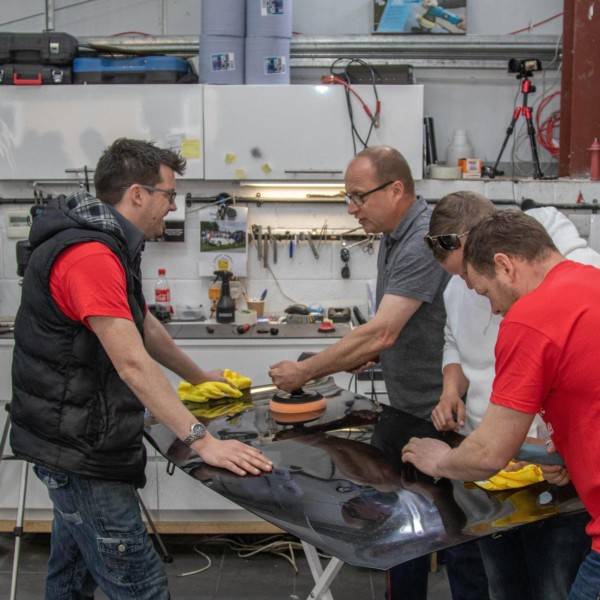Managing Expectations in the Car Care Industry.
The most successful detailing businesses are not the ones that deliver exactly what the customer asks for, but deliver the best possible outcome with a balance of factors, anticipating potential problems before they become problems. A large proportion of new customers coming to a detailer for the first time will either come pre-loaded with assumptions – stemming from friends or social media, assumed knowledge, or internet crowd-sourced research – or absolutely zero knowledge, relying on the professional to guide them on the best course for their needs. Both of these scenarios are potentially problematic if mishandled.
The car care industry thrives on trust and customer satisfaction. Ensuring that clients’ expectations are met, and exceeded where possible, is essential for building a loyal customer base and reputation. In this blog, we’ll delve deep into the intricacies of managing customer expectations in the car care industry, highlighting key strategies and best practices that can help businesses navigate this challenging terrain effectively.
Clear communication and avoiding bafflement is key:
“Bullsh*t baffles brains” is a sales technique used by those who want to appear so competent that a customer will believe everything else they say unquestioningly, arriving at the decisions they want, rather than what the customer wants. This could include spouting fourth-hand chemistry, dropping niche acronyms, calling out competitors, and leaving the customer wide-eyed and nodding in an attempt to keep up with the impossible.
However, clear and effective communication is the engine that powers customer satisfaction in the car care industry, and service industry as a whole. From the moment a customer walks through the door or contacts you for service, it’s crucial to establish a rapport built on trust and transparency, rather than steamrolling over what they want, to get to what you want.
Initial Consultation: During the initial consultation, take the time to listen to the customer’s concerns, circumstances, and requirements carefully. Ask questions to understand their expectations, and be attentive to their specific needs and situations. This step sets the foundation for a positive customer experience.
Service Explanation: When explaining the services you offer, provide detailed information about what each service entails. Use layman’s terms if necessary to ensure customers understand exactly what they are and are not paying for, avoiding any ambiguity that might lead to misunderstandings later on. For Example, when selling a coating that lasts for 3 years, make sure they understand this time span is caveated “with proper care and maintenance”, and highlight the figure is based on 3 years of average 10k mile a year car use, not a 50k mile a year sales reps car.
Estimate and Timelines: Be realistic when providing estimates for the cost and duration of services. Over-promising and under-delivering can lead to dissatisfaction. If there is any uncertainty regarding the timeframe or potential additional costs, it’s crucial to communicate this upfront. For Example. If you rely on a convertible roof drying completely before sealing and a cold day could delay the process, tell them that and say you’d rather keep a car overnight in this case and coat it the next day, so they are prepared for that eventuality, however unlikely.
Setting Realistic Timeframes:
Time is often of the essence for car owners, especially when they rely on their vehicles for daily commutes or essential tasks. Consequently, managing time-related expectations is paramount in the car care industry.
Accurate Scheduling: Maintain a well-organized appointment system that minimizes waiting times for customers. Strive to stick to scheduled appointments as closely as possible, and if delays are unavoidable due to weather inform the customer both promptly, and when making a booking if it may become a factor, with alternative solutions ready to go in case things need rearranging.
Transparency: In cases where services might take longer than initially estimated, inform the customer of the delay and provide a revised timeline. Honesty is appreciated, and customers will understand if they are kept informed.
Price Transparency is Key:
Detailing services often come with price tags that can cause customers anxiety if the range is too vague. Price transparency is critical to managing expectations effectively and preventing unpleasant surprises.
Detailed Quotes: Provide customers with detailed quotes that itemize job costs where possible, including any additional fees. This approach ensures customers are fully aware of what they are paying for, reducing the likelihood of disputes. This doesn’t mean you need to charge per squirt of shampoo, but if a customer knows that a normal interior valet price is X, and they’ve asked you to complete extra work such as shampooing a seat, detail this on the quote as a separate item so they can see the charge, question it if necessary, and associate it with their request.
Explaining Extra Costs: Sometimes, unforeseen issues may arise during a car service. If this happens, communicate these issues to the customer immediately, explaining why additional costs are necessary. Seek approval before proceeding with any unplanned work, preferably in writing via email, or an initiled note on a job form with the additional amount clearly quoted.
Quality Assurance Drives Loyalty:
One of the sure-fire ways to meet customer expectations is by consistently delivering high-quality service. Here’s how to make sure you hit the mark:
Skilled professionals: Skilled and certified professionals who can perform services efficiently and accurately are 90% of the customer service battle. Whether employees, or just yourself, taking professional development time to become well-trained instils confidence in customers, both before an initial meeting, and is enhanced after they’ve seen your work product.
Quality materials: Use high-quality chemicals and tools, in range of the price point you can achieve. Customers appreciate the assurance that their vehicles are in the best possible hands, and part of that is using products you know can achieve consistent and safe results, and help you fulfil your commitments to quality.
Thorough Inspections: Conduct thorough inspections before and after working on vehicles. This helps identify potential issues early and ensures that customers receive their vehicles in excellent condition. This could be in the form of pre and post-inspection forms, with checkboxes to ensure a thorough job, digital tools for measurement of paint depths and gloss levels can be employed in some circumstances, and photographs both before, during and after to accompany an after job report – often a feature of CRM systems – is ideal to communicate to a customer the effort you put into achieving the results requested.
Feedback Loop for Continuous Improvement:
To manage customer expectations effectively, create a feedback loop that allows customers to express their thoughts, concerns, and suggestions.
Encourage Feedback: Actively encourage customers to provide feedback – both positive and negative/critical – on their experience. This can be done through follow-up emails, surveys, or suggestion boxes at your facility. For Example: If multiple customers are happy, but point out a similar service missing they would have expected as part of the job, perhaps it’s something you should build into quotes going forward?
Prompt Responses: Respond promptly to any customer feedback, addressing concerns and suggestions professionally. Show that you value their input and are committed to improving your services.
Implement Changes: Use the feedback received to make necessary improvements to your services and processes continually. Inform customers if you make an active change based on their suggestions – Customers appreciate knowing that their input leads to positive changes.
Going the Extra Mile:
Sometimes, exceeding customer expectations involves going beyond the standard services. This doesn’t mean doing work which would usually be chargeable for free – we wrote a blog on that here – But addressing small touches that stick in the minds of your clients can have a greater impact. Here are a few ways to stand out:
Personalization: Take note of customer preferences and tailor your services accordingly. Whether it’s offering a specific type of screenwash, wax, customizing cleaning products, or an area cleaned you wouldn’t usually address at a certain service level, personalization goes a long way.
Courtesy Services: Provide complimentary services like air fresheners, screenwash top ups, a branded microfibre for wiping screens, little things stick in customer minds as benefits of what is a “luxury” service.
Educational Content: Share informative content with your customers, such as maintenance tips and advice on how to extend the life of their vehicle’s coating without having to come back to you. This demonstrates your commitment to their long-term satisfaction without a compulsion to give you more money, even if they do want you to take care of it going forward.
Summary
In the car care industry, managing customer expectations isn’t just a best practice—it’s a necessity for building trust, earning loyalty, and ensuring repeat business. Clear communication, transparency in pricing and timelines, delivering top-notch quality, actively seeking feedback, and leveraging technology are all critical components of effective expectation management.
By consistently following these strategies, car care businesses can navigate the road to customer satisfaction with confidence and success, bringing a trail of loyal customers along with them for the ride.
Customer engagement is just one part of our Professional Development Courses, as it’s a skill crucial to your business success. When you come on any of the Levels, you’re taught not just how to achieve the practical elements, but how to run the business, from health and safety to regulations and customer acquisition.
Sound like the course for you? Find out more about them here
![]()


